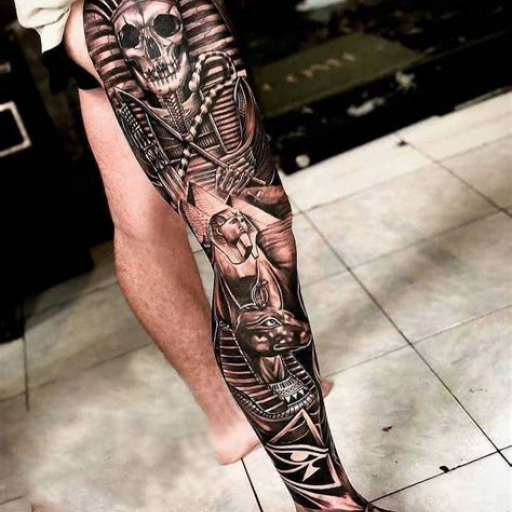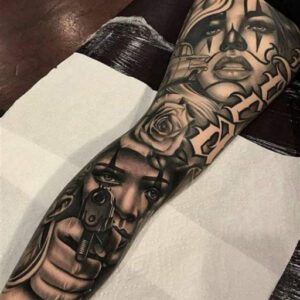Getting inked is a popular way for guys to express themselves and showcase their creativity. One of the most popular and eye-catching tattoo placements is the leg sleeve, which extends from the ankle to the thigh. Whether you’re a seasoned tattoo enthusiast or considering your first piece, a leg sleeve can be a transformative and meaningful addition to your body art.
With endless possibilities in terms of designs, styles, and themes, finding the perfect leg sleeve tattoo ideas for guys can be an exciting endeavor. From intricate tribal patterns to realistic landscapes, the options are limitless. To inspire your next tattoo journey, here are some unique and striking leg sleeve tattoo ideas for guys.

Japanese-Inspired Sleeves
Japanese-inspired leg sleeves are renowned for their vibrant colors, bold lines, and intricate detailing. These tattoos often depict traditional Japanese imagery, such as cherry blossoms, dragons, samurais, and geishas. The beauty of Japanese-inspired leg sleeves lies in their ability to combine cultural symbolism with artistic flair, creating a visually stunning and meaningful piece.
Samurai tattoos, in particular, hold great significance in Japanese culture, representing honor, loyalty, and strength. A samurai leg sleeve can feature a warrior in full armor, wielding a katana or participating in a fierce battle. The intricate details of the samurai’s clothing, armor, and facial expressions bring the tattoo to life, creating a powerful and evocative work of art.
Polynesian Tribal Sleeves
Polynesian tribal leg sleeves are another popular choice for guys looking for bold and impactful tattoos. These tattoos draw inspiration from the traditional art of the Polynesian islands, featuring intricate geometric patterns, sharp angles, and powerful symbols. Polynesian tribal leg sleeves often cover the entire leg, creating a cohesive and visually arresting design.
The designs within a Polynesian tribal leg sleeve can vary greatly, each holding its own unique meaning and symbolism. Tiki faces, known as tiki atua, represent deities and ancestors, while turtle shells symbolize longevity and protection. The intricate patterns and motifs woven throughout the tattoo create a sense of depth and texture, resulting in a captivating and meaningful work of art.
Biomechanical Sleeves
For those who prefer a futuristic and mechanical aesthetic, biomechanical leg sleeves offer a unique and eye-catching option. These tattoos blend human anatomy with mechanical elements, creating the illusion of exposed gears, wires, and pistons beneath the skin. Biomechanical leg sleeves often feature metallic greys, blues, and blacks, giving them a realistic and somewhat surreal quality.
The intricate detailing of biomechanical leg sleeves requires a skilled tattoo artist who can capture the illusion of depth and texture. The seamless integration of mechanical components with human anatomy creates a striking and thought-provoking tattoo design that is sure to turn heads.
Realism Sleeves
Realism leg sleeves are a testament to the exceptional skill and artistry of tattooists who specialize in capturing lifelike images on skin. These tattoos often depict scenes from nature, portraits of individuals, or even historical events. The level of detail in realism leg sleeves is simply breathtaking, creating the illusion that the tattoo is a window into another world.
Popular themes for realism leg sleeves include landscapes, seascapes, and wildlife. A skilled tattoo artist can bring the beauty of the natural world to life on your leg, creating a breathtaking and immersive tattoo experience. Portraits of loved ones or iconic figures can also be rendered with incredible realism, capturing their essence and emotions in a permanent and meaningful way.
Conclusion
When it comes to leg sleeve tattoo ideas for guys, the possibilities are as vast as your imagination. Whether you prefer traditional Japanese designs, intricate Polynesian patterns, futuristic biomechanical aesthetics, or lifelike realism, there’s a leg sleeve tattoo that will resonate with your personality and style. Embarking on a leg sleeve tattoo journey is a significant commitment, but with careful planning and a skilled tattoo artist, you can create a masterpiece that will adorn your body and tell your story for years to come.
Remember, the most important aspect of any tattoo is finding a design that holds personal meaning and significance for you. Embrace the creative process, explore different tattoo styles, and work closely with your tattoo artist to bring your vision to life. With a well-executed leg sleeve tattoo, you’ll not only turn heads but also carry a unique and meaningful work of art with you wherever you go.
FAQ
What is the best placement for a leg sleeve tattoo?
The ideal placement for a leg sleeve tattoo is from the ankle to the thigh, covering the entire calf and thigh area. This provides ample space for intricate designs and allows for a cohesive and impactful tattoo.
How long does it take to get a leg sleeve tattoo?
The completion time for a leg sleeve tattoo varies depending on the size, complexity, and detail of the design. It can take multiple sessions over several months or even years to complete a full leg sleeve tattoo.
Is a leg sleeve tattoo painful?
The pain level of a leg sleeve tattoo varies from person to person and the specific areas being tattooed. The calf and thigh areas generally have more muscle and fat, making them less painful compared to areas with thinner skin and fewer muscle layers.
How do I care for a leg sleeve tattoo?
Proper care is crucial for a successful leg sleeve tattoo. Follow your tattoo artist’s instructions carefully, which typically involve keeping the tattoo clean and dry, applying a healing ointment, and avoiding strenuous activity.
What are some popular design themes for leg sleeve tattoos?
Popular leg sleeve tattoo themes include Japanese-inspired designs, Polynesian tribal patterns, biomechanical aesthetics, realism, and nature scenes. Ultimately, the choice of design is a personal preference and should reflect the individual’s unique style and interests.



